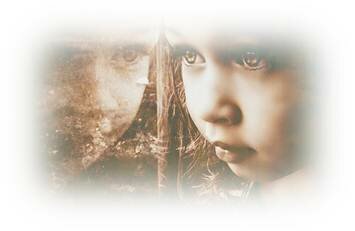Characteristics For Autism Spectrum Disorders

Characteristics for Autism Spectrum Disorders or ASD represent a complex of severe developmental disorders that affect a person's ability to communicate, form relationships with others, and respond appropriately to the environment.
Not until the middle of the twentieth century was there a name for a disorder that now appears to affect an estimated 3.4 every 1,000 children ages 3-10, a disorder that causes disruption in families and unfulfilled lives for many children.
In 1943 Dr. Leo Kanner of the Johns Hopkins Hospital studied a group of 11 children and introduced the label early infantile autism into the English language also providing characteristics for autism disorders.
At the same time a German scientist, Dr. Hans Asperger, described a milder form of the disorder that became known as Asperger syndrome.
The most recent characteristics for Autism Spectrum Disorders and diagnostic criteria are provided by The American Psychiatric Association Diagnostic and Statistical Manual, Fourth Edition, (DSM-IV-TR).
Until 1994, autism was classified as a disorder without reference to pervasive developmental disorders. Currently characteristics for Autism Spectrum Disorders are viewed as a spectrum disorders that is under the rubric of pervasive developmental disorders, which includes disorders that cause severe deficits early in a childs development. Pervasive Developmental Disorders (PDD) include:
- Autistic Disorder
- Retts Disorder
- Aspergers Disorder
- Childhood Disintegrative Disorder
- Pervasive Developmental Disorder not Otherwise Specified (including Atypical Autism)
Those affected may avoid making eye contact and lack the ability to read faces for signs of emotion or other cues. Children with ASD typically do not engage in social play or games with their peers. Unusual behaviors such as rocking, hand-flapping or even self-injurious behavior may be present in some cases. Individuals with ASD have unusual social, communicative and behavioral development and may have abnormalities in cognitive functioning, learning, attention and sensory processing.
Early Symptoms Of Autism
The early symptoms of autism spectrum disorders can often be reliably detected by the age of 3 years, and in some cases as early as 18 months.
Studies suggest that many children eventually may be accurately identified by the age of 1 year or even younger.
The appearance of any of the warning signs of autism is reason to have a child evaluated by a professional specializing in these disorders.
Parents are usually the first to notice unusual behaviors in their child. In some cases, the baby seemed different from birth, unresponsive to people or focusing intently on one item for long periods of time.
If you suspect your child showing an early symptoms of autism, e.g. having a developmental disability affecting verbal and nonverbal communication and social interaction; or may have behavioral characteristics of autism, such as engagement in repetitive activities and stereotyped movements, resistance to environmental change or changes in daily routines, or unusual responses to sensory experiences consider answering the following additional questions:
- Is his speech repetitive, e.g. like an echo?
- Is he reluctant or is it hard for him to make an eye contact?
- Does he lack the ability to play with other children?
- Does he shy away from being touched?
- Does he spin toys or other objects around and around?
- Does he seem unafraid of things that he should be afraid of?
- Does he like to watch the same program or movie over and over again?
- Does he like to put objects in a row?
- Is he fascinated with numbers and letters?
Autism symptoms checklist is much wider, but if most of your answers are positive, seek medical advice as soon as possible because in case of diagnosing autism the early intervention is most important. Learn more about early symptoms of autism...
Autism Statistics
The U.S. government survey on the rate and characteristics for autism - the Centers for Disease Control (CDC) found that the rate is higher than the rates found from studies conducted in the United States during the 1980s and early 1990s (survey based on data from 2000 and 2002). The CDC survey assigned a diagnosis and characteristics for autism spectrum disorder based on health and school records of 8 year olds in 14 communities throughout the U.S.
Debate continues about whether this represents a true increase in the prevalence of autism. Changes in the criteria used to diagnose autism, along with increased recognition of the disorder by professionals and the public may all be contributing factors. Nonetheless, the CDC report confirms other recent epidemiologic studies documenting that more children are being diagnosed with an ASD than ever before.
Data from an earlier report of the CDC's Atlanta-based program found the rate of autism spectrum disorder was 3.4 per 1,000 for children 3 to 10 years of age. Summarizing this and several other major studies on autism prevalence and characteristics for autism disorders, CDC estimates that 2-6 per 1,000 (from 1 in 500 to 1 in 150) children have an ASD.
Compared to the prevalence of other childhood conditions, this rate is lower than the rate of mental retardation (9.7 per 1,000 children), but higher than the rates for cerebral palsy (2.8 per 1,000 children), hearing loss (1.1 per 1,000 children), and vision impairment (0.9 per 1,000 children). The CDC notes that these studies do not provide a national estimate.
Autism crosses all racial and ethnic boundaries. However, among other characteristics for Autism, gender difference does appear in the research: three out of every four people with autism are male.
Learn more about Autism types, Autism And Vaccinations, early symptoms of Autism, a rationale behind Autism treatments...
Return from Characteristics For Autism Spectrum Disorders to the Home Page












